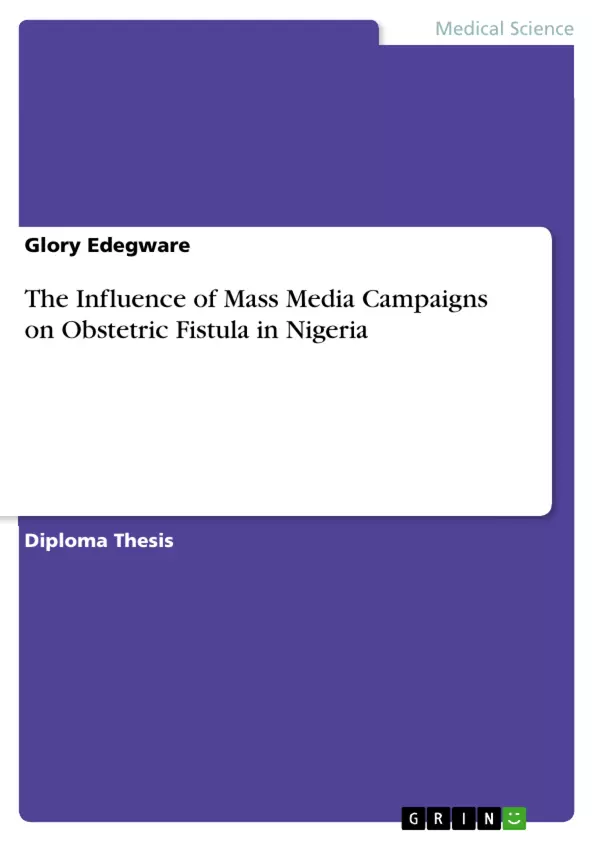A persistent, involuntary release of urine or faeces into the vagina is a symptom of obstetric fistula, an improper connection between the urinary bladder and the vagina.
This study analyses the effect that public awareness programmes have had on the prevalence of obstetric fistula in Nigeria. The researcher used a survey approach to collect data for this study, and a well-crafted questionnaire was used to elicit participant feedback.
Media campaigns have been used by governments, people, groups, and other public entities for a long time in an effort to better the public’s health. This work has been applied to every facet of the human experience. The goal of these initiatives is to raise public consciousness to a level where individuals will be better able to steer their own lives.
These efforts have often been focused on aiding one or the other sex. Breast cancer awareness, cervical cancer awareness, pelvic inflammatory disease awareness, vaginal fistula awareness, and obstetric fistula awareness are just a few examples of campaigns that show how important these issues are to women. For this reason, the impact of a media campaign on the incidence of obstetric fistula in Nigeria is assessed here.
Inhaltsverzeichnis (Table of Contents)
- ABSTRACT
- CHAPTER ONE
- INTRODUCTION
- 1.1 Background of the Study
- 1.2 Statement of the Problem
- 1.3 Objectives of the Study
- 1.4 Research Questions
- 1.4Scope of the Study
- 1.5 Significance of the Study
- 1.6 Limitation of the Study
- 1.7 Definition of Terms
- CHAPTER TWO
- LITERATURE REVIEW AND THEORETICAL FRAMEWORK
- 2.1. Review of Relevant Literature
- 2.2 Theoretical Framework
- CHAPTER THREE
- RESEARCH METHODOLOGY
- 3.1. Research Design
- 3.2. Population of the Study
- 3.3. Sample Size
- 3.4. Sampling Procedure
- 3.5. Validity of the Instrument
- 3.6. Reliability of the Instrument
- 3.7. Method of Data Collection
- 3.8. Method of Data Analysis and Discussion
- CHAPTER FOUR
- DATA PRESENTATION AND ANALYSIS
- 4.1. Preamble
- 4.2. Analysis of Respondents' Bio-Data
- 4.3. Presentation and Analysis of Psychographic Data Collected
- 4.4. Discussion of Findings
- CHAPTER FIVE
- SUMMARY, CONCLUSION AND RECOMMENDATIONS
- 5.1. Summary
- 5.2. Conclusion
- 5.3. Recommendations
- REFERENCES
- APPENDIX
Zielsetzung und Themenschwerpunkte (Objectives and Key Themes)
This research study aims to investigate the impact of public awareness campaigns on the prevalence of obstetric fistula in Nigeria. The study utilizes a survey approach to gather data from residents of Niger State, exploring their understanding of obstetric fistula and the effectiveness of awareness campaigns.
- The influence of mass media campaigns on public awareness about obstetric fistula in Nigeria
- The effectiveness of communication channels employed in these campaigns
- Challenges faced in utilizing mass media for raising awareness about obstetric fistula
- The impact of awareness campaigns on reducing the prevalence of obstetric fistula
- Recommendations for improving the efficacy of future campaigns
Zusammenfassung der Kapitel (Chapter Summaries)
Chapter One introduces the study's background, highlighting the prevalence of obstetric fistula in Nigeria and the role of mass media in public health campaigns. It outlines the research problem, objectives, research questions, scope, significance, limitations, and key terms. Chapter Two delves into the relevant literature and theoretical framework underpinning the study, providing insights into previous research and existing theories related to obstetric fistula, mass media, and public health campaigns. Chapter Three details the research methodology employed, including the research design, population, sample size, sampling procedure, instrument validation, reliability, data collection methods, and data analysis techniques. Chapter Four presents and analyzes the collected data, focusing on respondents' demographics, psychographic characteristics, and their understanding of obstetric fistula. It discusses the findings, interpreting the results within the context of existing research and theories.
Schlüsselwörter (Keywords)
This research study focuses on the critical issues of obstetric fistula, mass media, public awareness campaigns, health communication, and community engagement in Nigeria. It explores the effectiveness of various communication channels, such as radio, television, and word-of-mouth, in raising awareness about this significant health problem. The study aims to contribute to a better understanding of how to utilize mass media strategically to address obstetric fistula in Nigeria and implement effective intervention strategies.
- Quote paper
- Glory Edegware (Author), 2022, The Influence of Mass Media Campaigns on Obstetric Fistula in Nigeria, Munich, GRIN Verlag, https://www.grin.com/document/1271922



